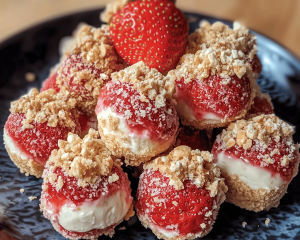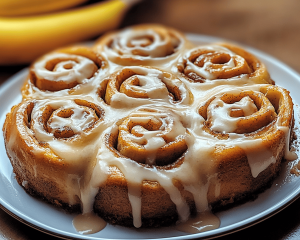There’s a special magic that envelops the kitchen when you decide to make crepes. It’s a delicate dance of batter and heat, a swift flip that conjures memories of mornings spent with loved ones, lazy Sundays, and culinary adventures that spark joy. The first time I made crepes was an ordinary Saturday morning, yet it became one of those precious moments frozen in time. I was twenty-three, fresh out of college, and living in a tiny studio apartment with a view that overlooked the bustling streets of my small town. The air was crisp with the promise of spring, and I was aching for a recipe that summoned warmth and cheer.
A friend had shared her grandmother’s crepe recipe with me, a worn-out piece of paper dotted with flour marks and scribbled notes that felt comforting. It called for simplicity—just a few ingredients mingling together to create something ethereal. For me, crepes were more than just a dish; they were a canvas, a testament to the joy of cooking and sharing. So, I gathered my ingredients, nerves tingling with anticipation, ready to transform a simple batter into something that would bring a smile to my face, and perhaps even a few favorites to my little table.
As the first crepe hit the skillet, I held my breath, expecting magic. The sizzle and steam filled my tiny kitchen, and the fragrance was an intoxicating blend of warm flour and eggs. I remember the moment I flipped it—my stomach somersaulted, a mix of excitement and anxiety, because we all know that one fateful flip can make or break the crepe experience. And when it landed perfectly on the other side, golden and inviting, I couldn’t help but let out a small cheer. That first taste—light, airy, and delicate—was heaven. With each subsequent crepe, I learned to let go of the pressure, embracing every slight imperfection as just part of the charm.
Inside the Ingredients of The Best Crepes
Let’s talk about the stars of this story: the ingredients. Each one plays a crucial role, bringing its character into the mix, ensuring that every bite evokes a sense of nostalgia and delight.
All-Purpose Flour: This is the backbone of the crepe batter. The flour provides structure while keeping things tender and light. I’ve tried using other flours—whole wheat, buckwheat—but I always return to the classic all-purpose. It absorbs just enough moisture, creating the perfect texture that holds onto any filling you dare to dream of. When I sift the flour, I visualize myself unpacking memories—each scoop a recollection of breakfasts shared and dreams fulfilled.
Eggs: Eggs are where the magic lies, binding everything together and enriching the flavor. They contribute to the tenderness that makes each crepe melt in your mouth. I recall a time when I mistakenly used eggs that were just a tad too old. The crepes became a bit rubbery, and while they still tasted fine, the texture was far from what I remembered. Fresh, organic eggs—they make all the difference in creating that ideal fluffiness that defines crepes.
Milk: Milk brings moisture and creaminess to the batter. It’s essential for creating a smooth and fluid consistency, allowing the crepe to spread elegantly across the surface of your pan. I often use whole milk, but I’ve had success with almond milk when I’m feeling adventurous. The subtle sweetness from the milk pairs beautifully with whatever sweet or savory filling I choose. Sometimes, just the mere act of pouring milk invites old memories of cozy evenings spent storm-watching, sipping hot chocolate while planning the menu for the week ahead.
Butter: Ah, butter—the magical ingredient that adds richness and flavor. I remember my first few batches when I skimped on the butter, trying to convince myself that it wasn’t necessary. What a mistake! Adding melted butter into the batter gives the crepes a lusciousness that’s worth every calorie. It also ensures that they slide gracefully out of the pan. This is one ingredient that reminds me of my mother, who would always say, “Butter makes everything better.” Truer words have never been spoken.
Salt: While it’s just a tiny pinch, salt is crucial. It enhances the sweetness of the crepes and balances flavors. Never underestimate the power of salt—it’s the unsung hero in countless dishes. I learned early on that too little leaves the crepes tasting flat, while too much can overwhelm. Just a touch brings out that signature flavor that leaves you coming back for more.
How The Best Crepes Fits Into a Balanced Life
Life is all about balance—between work and play, health and indulgence. Making crepes encompasses this beautifully. They can be as rich or as wholesome as you choose. On days when I want something light, I’ll play around with fillings like Greek yogurt and berries, topped with a drizzle of honey. When I’m in the mood to treat myself, I embrace the decadence of Nutella and whipped cream with pecks of fresh strawberries.
In a world that often pressures us to choose between enjoyment and health, crepes allow us to straddle that line effortlessly. I’ve learned to let go of guilt when I whip up a batch loaded with chocolate and whipped cream—after all, these moments remind me to embrace joy unconditionally. A few years back, during a particularly challenging period in my life, crepes became my solace. They were a way to create something beautiful amidst chaos. Whenever I finished a batch, I felt a sense of accomplishment; it was my way of nurturing my spirit through food.
Hearing friends rave with delight at a crepe brunch, void of restraint, brought warmth that I cherish. These gatherings became celebrations of connection—living proudly in my kitchen with laughter and stories swirling around like the sweet aroma of warm batter. In this way, pancakes and waffles, though loved dearly, simply couldn’t lure me back from the delicate embrace of crepes.
What You’ll Need
– 1 cup all-purpose flour
– 2 large eggs
– 1 1/4 cups milk (whole or almond)
– 2 tablespoons butter, melted (plus extra for cooking)
– 1/4 teaspoon salt
Yields about 8-10 crepes.
Preparing The Best Crepes Step by Step
Here’s where the magic happens—gather your ingredients and blend them into something spectacular.
First, start by whisking together the flour and salt in a large mixing bowl. I like to take a moment here to breathe deeply and enjoy that raw, earthy smell. It reminds me that I’m beginning something simple yet sublime.
Next, create a well in the center, and crack in the eggs. Whisk gently, coaxing them into the flour until they’re no longer resilient, and then slowly pour in the milk, a little at a time. It’s a soothing rhythm—whisk, pour, whisper sweet nothings to the batter. With each stroke, watch as the ingredients meld together, first lumpy, then smoothly liquid. This is the essence of transformation!
When the batter is velvety—without a lump in sight—stir in the melted butter. It adds a richness that speaks volumes about self-care. Let the batter rest for about 30 minutes, allowing the gluten to relax. Trust me; it’s worth the wait. You’ll want to chat with someone during this pause, after all, cooking is always better when shared.
Now, heat a non-stick skillet over medium-low heat. Add a small pat of butter to coat the surface. Once it melts and the pan is shimmering, it’s time to pour—in my case, I ladle about a 1/4 cup of batter into the pan. Here’s where the magic begins: angle the pan gently to let the batter swirl and cover the surface evenly. Time it—about 1-2 minutes, until the edges begin to lift, and the center appears set. It requires practice, so don’t panic if it looks a bit messy—mine always does, and it’s endearingly imperfect.
When the first crepe is ready, flip it with a quick wrist motion (or with a spatula if you’re fancy!). Let it cook for another minute, then slide it onto a plate. Repeat, buttering the pan as needed, and enjoy that smell wafting through your house. It’s bliss.
Lessons from My Kitchen
Cooking is often lessons wrapped in beautiful packages. When I first delved into crepe-making, I faced a few mishaps—burnt edges, lumpy batter, crepes that stubbornly refused to flip. Those moments were frustrating, but they taught me patience and importance in understanding heat. Years later, I delight in experimenting with different fillings and toppings. One winter, I went for a savory style, filling them with sautéed mushrooms and spinach, topped with a creamy béchamel, and it became an instant family favorite! I recorded the recipe promptly in my journal, a little trophy of my evolving skills.
I often reflect on one quote from Julia Child that never fails to inspire me: “You don’t have to be a chef to cook. You just need a love of cooking.” It resonates with me because it captures the essence of what cooking represents—an opportunity to share love and laughter.
As seasons shift, I also adapt my fillings—apples with cinnamon in autumn, zesty lemon curd in spring—inviting nature into my kitchen while allowing my taste buds to dance across the calendar.
I am grateful for the creativity that this dish inspires, bringing warmth into my kitchen while allowing me to connect with my loved ones through shared memories and shared plates.
With crepes, I’ve realized that even when things get chaotic, when the universe feels overwhelming, I can always return to this simple yet profound act of creation. It reminds me to embrace the journey—and oh, it always tastes delicious.
(Closing Thought)
In life, just as in cooking, it’s about the relationships cultivated, the flavors intertwined, and the moments shared. The best crepes hold more than taste; they cradle memories, fortify friendships, and whisper stories of joy, heartbreak, and resilience. I invite you to explore this recipe—experiment, fail, triumph, and let it take you on a journey as unique as your culinary fingerprints.
So, gather your loved ones, pour yourself a cup of tea, and let this humble batter transport you down memory lane, with warmth and laughter in every bite. Happy cooking!


